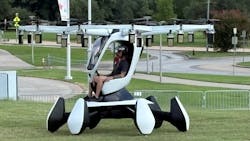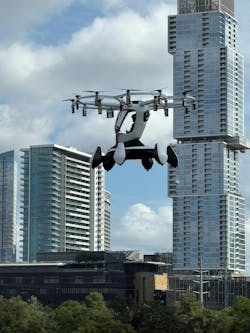Regional Airports Planning for Future Aviation Technology
Fives Things You'll Learn
- Regional airports serve as vital connectors, supporting local economies and easing congestion at larger hubs through shorter travel times and easier access.
- Federal investments, such as the Bipartisan Infrastructure Law, are fueling modernization efforts, including upgrades to infrastructure and the development of vertiports for eVTOL aircraft.
- Planning for future technologies involves comprehensive surveys, demand studies, and community engagement to ensure sustainable and efficient airport development.
- Upgrading air traffic control systems and expanding runways are essential to safely manage increased traffic from traditional aircraft and emerging electric vertical takeoff vehicles.
- Collaboration with eVTOL manufacturers and stakeholders is key to installing necessary utility infrastructure like charging stations and ensuring compatibility with current airport layouts.

EVTOLs mean airports must also rethink runways, taxiways, and nearby buildings.
Regional airports, designed to supplement local communities by connecting them to regional and national markets, are changing quickly to shape the future of aviation. In fact, these general aviation airports are now leading innovation as the industry moves toward advanced air mobility, or AAM. Federal investments and new FAA guidance, like Vertiport Design Brief 105A, are helping airports plan for electric vertical takeoff and landing (eVTOL) aircraft.
Such aircraft are quieter, produce fewer emissions, and make travel more accessible for people and cargo. In addition to those benefits, the growth of electric aviation and vertiports could boost local economies and change how we travel.
Regional airports are a major component of the National Airspace System (NAS) and will continue to be the unsung heroes of the aviation world as such facilities power local communities, while increasing accessibility and relieving pressure from major hubs. By definition, these airports largely serve general aviation and non-scheduled air travel by connecting communities to national and even global markets with corporate business activity and critical community services. Generally located in metropolitan areas, they serve relatively large populations and can have high levels of jet and multiengine propeller aircraft. Many travelers prefer regional airports to the hassle of the giant airport – shorter commute times, no security lines, and easier parking can make for a better experience. Their economic power can often be overlooked as well. For example, across Texas alone, more than 260 general aviation airports account for nearly 50,000 jobs and more than $9 billion in total economic output. In addition, regional airports often can be remodeled and constructed more economically and more sustainably.
Driving much of the interest in the development of regional airports is the Bipartisan Infrastructure Law, introduced a couple of years ago, which has brought major federal investment to aviation, sending billions of dollars to airports. For regional airports, this funding is both a much-needed boost and a challenge. Many still require critical repairs and upgrades, but preparing for the future is equally important. Airports, both big and small, need to accommodate ever-changing technologies such as electric aircraft and advanced air mobility, many of which are already here and will be expanding in the future. This means planning for tomorrow’s technology today.
One big challenge, of course, is utility infrastructure. Vertiports and charging stations for eVTOLs will need reliable power and smart utility planning. Smaller airports, therefore, must balance immediate needs with preparing for new technology. Federal funding is a big opportunity, but its impact depends on how well airports combine traditional upgrades with new aviation demands. Modernization is indeed more than just new pavement or terminals. Good airport planning now means making upgrades that meet current needs and future opportunities. Many airports are partnering with eVTOL manufacturers to install this utility infrastructure such as charging stations and terminal facilities.
Air traffic control is also a top priority throughout the industry. As advanced air mobility grows, airports need modern towers and updated systems to manage busier airspace to safely add eVTOLs alongside traditional planes. Investing in these systems improves safety and helps smaller airports handle more traffic. Expanding runways and facilities is also key. Planners must now consider electric aircraft, not just commercial and general aviation. EVTOLs mean airports must also rethink runways, taxiways, and nearby buildings.
To that end, modernization starts with surveys and demand studies that look at local growth, economics, and feedback from stakeholders. These help airports make plans that balance long-term growth with budget limits. Using data helps airports match their facilities to future needs. New technology also needs to fit into current layouts. For example, vertiports should be placed to avoid disruption while also protecting nearby communities from noise or environmental problems. Planning for these sites includes making sure there is reliable and affordable charging as well. By planning carefully and working with the community, regional airports can lead in sustainable aviation and remain valuable to their communities.
In terms of logistics, FAA guidance, such as Vertiport Design Brief 105A, says that sites for AAM must be chosen to keep airspace safe and use land well. Following the previously mentioned surveys and studies, the data is compared to the current capacity to consider what upgrades are needed and possible. Airports can then decide where to place vertiports and charging stations, along with other improvements. These plans are added to the Airport Layout Plan and Capital Improvement Plan, which help airports receive FAA funding and grants.
For regional airports, flexible design and smart planning will decide if they succeed as aviation changes. In addition to new-age aircraft, airports must plan for passengers, operators, and the people who live and work nearby. By making modernization a shared effort of local community members and airport leaders, regional airports can show that progress does not have to come at the cost of community values. Regional airports may become, in some ways, cutting-edge, cleaner, and more sustainable than their much larger metropolitan cousins.
Although not as heavily traveled by frequent airline flyers, these facilities are now leading the way in air travel innovation. By adding advanced air mobility and working with stakeholders, regional airports are ready to lead the next era of aviation. Airports that only fix current problems may fall behind, while those that focus only on new technology may miss what their communities need now. The most successful regional airports will treat modernization as an ongoing effort. They will use federal funding, design with flexibility, and stay in tune with community priorities that will serve today’s travelers and help shape the future of air mobility. With the right approach, regional airports can support their communities and change how Americans think about travel.
About the Author

Michael Mallonee
Vice President - Aviation
Michael Mallonee joined KSA in 2015 as seasoned Aviation Planner with several years of experience encompassing aviation planning, grant contract oversight, airport system planning and regulatory compliance. Previously, Michael managed the aviation planning and education program as a Principal Transportation Planner for the North Central Texas Council of Governments, which serves as the Metropolitan Planning Organization for the Dallas-Fort Worth area. In this capacity, he led general aviation airport system planning and long-range development training. Additionally, Michael led the North Texas Aviation Education Initiative to facilitate regional aviation education programs that will sustain the aviation and aerospace workforce in North Texas.
Michael served as lead staff to the Air Transportation Technical Advisory Committee comprised of federal, state and local aviation officials. His other accomplishments include completion of a Joint Land Use Study surrounding the Naval Air Station Joint Reserve Base Fort Worth, surface access enhancement to airports, and special event planning for the North Texas Super Bowl XLV. His previous aviation experience also includes working as an aircraft dispatch and weather observer at Southern Illinois Airport in Carbondale, IL, and as a line service technician at Mid America Jet at Owensboro Regional Airport, in Owensboro, KY.

